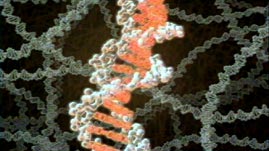Whether it is a microbe, a rose, or a dolphin, any form of life gets its building and operating instructions from the molecule of life, DNA. DNA comprises the genes and chromosomes that govern the development of an individual organism. Coiled inside the nucleus of the cell, DNA stores all the information needed in reproducing that individual.
The information of life is packaged in genes, the units of heredity, distributed along the chromosomes of an organism; a human being has as many as 30,000 genes, and perhaps more. Each gene contains a coded instruction for making a single protein. The chemical code in which the information is written is stunningly simple, consisting of only four different chemical bases, or nucleotides: adenine (A), thymine (T), cytosine (C), and guanine (G). But various combinations of those four bases -- say, A A C G G A C T T A and so on, for thousands of "letters" -- can spell out the recipes for tens of thousands of different proteins.
In manufacturing the proteins it needs, the cell uses the gene sequence as a blueprint. A different nucleic acid molecule, known as messenger RNA, makes a copy of the gene sequence and carries it outside the nucleus. The message encoded in the messenger RNA is read by structures called ribosomes, which assemble the protein out of amino acids in the cell's cytoplasm. Each amino acid is specified by a combination of three of the chemical bases (the A, T, C, and Gs), and the amino acids are put together in a long chain to form the protein. The cell then uses the protein or sends it out of the cell to perform some job for the body.
When a cell divides, it makes a copy of its DNA instructions for the new cell. The twisted double strand structure -- the famed double helix -- unwinds and the strands separate. The nucleotides (A, T, G, and C) on each strand pair up with free nucleotides in the nucleus, creating two new strands. But only G can pair with C, and only T can pair with A. Therefore, the order of nucleotides in the original strand specifies the order in the new strand. After each of the old strands is copied in this way, there are two new double-helix molecules, each one containing one strand it inherited from the original molecule and one newly-formed strand.
Often this copying process makes errors, so that the wrong nucleotide is placed in position. The cell can correct these errors, called mutations, but some inevitably get through. How often these mutations are advantageous, neutral, or harmful to an organism depends on the genes affected and their cellular functions.

 Loading Standards
Loading Standards Teachers' Domain is proud to be a Pathways portal to the National Science Digital Library.
Teachers' Domain is proud to be a Pathways portal to the National Science Digital Library.
